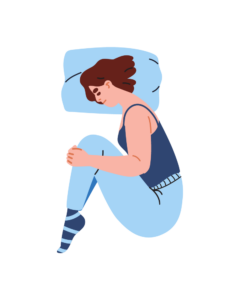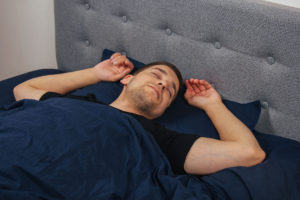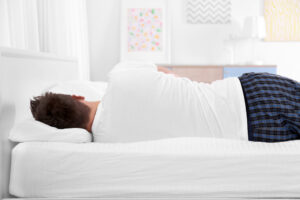Fetal Sleep Position
At a Glance
The fetal sleeping position—lying on your side with knees curled toward your chest—is one of the most common sleep postures among adults. It can promote spinal alignment, reduce snoring, and provide comfort for pregnant people and those with back pain. However, curling too tightly may cause joint stiffness or restrict deep breathing.
There’s no one-size-fits-all approach to sleeping positions. Some people find sleeping on their backs to be the most comfortable, while others find stomach sleeping to be the best position for their bodies. Ultimately, it comes down to what feels most comfortable to you.
Researchers often divide sleep positions into three categories: back, stomach, and side sleeping . Side sleeping is the most common position, with sleepers spending 54% of each night on their sides, on average. Within each sleep position category, however, there are subtle variations. The fetal position, for example, is a specific form of side sleeping.
What Is the Fetal Sleep Position?

The fetal position involves lying on your side with your knees drawn up toward your chest, often with your arms tucked in or one arm placed under the pillow for support. It’s named after the curled-up posture of a fetus in the womb.
Side sleeping is the most common sleep position overall, and while there’s limited data on how many people specifically curl into the fetal posture, preference for side sleeping tends to increase with age . Young children often shift between sleeping on their backs, stomachs, and sides, while older adults are more likely to favor side sleeping.
What Are the Benefits of the Fetal Sleep Position?
Sleeping in the fetal position offers several potential benefits, especially when done in a relaxed, non-restrictive way.
- Supports spinal alignment: When paired with a supportive mattress and pillow, the fetal position can help maintain the spine’s natural curve, reducing strain on your back and neck.
- May reduce snoring and sleep apnea symptoms: Side sleeping, including in the fetal position, helps keep the airways open and can reduce snoring or mild obstructive sleep apnea, especially when compared to back sleeping.
- Can help prevent acid reflux: Studies show that sleeping on your left side can help promote better digestion and may help reduce heartburn by preventing stomach acid from flowing back into the esophagus.
- Eases discomfort during pregnancy: For pregnant individuals, especially in the third trimester, lying in the fetal position on the left side can improve circulation, reduce pressure on internal organs, and support the growing belly.
- Offers a sense of security: Some people find the curled-up position emotionally comforting. It may help the body and mind relax by mimicking the protective posture of the womb, making it easier to fall and stay asleep.

What Any the Potential Drawbacks?
While the fetal position can feel cozy and comforting, especially for those with back pain or during pregnancy, it’s not without potential downsides.
- Joint and muscle stiffness: Curling your body tightly can restrict movement and place extra pressure on your joints — particularly in the knees, hips, and spine. Over time, this may lead to stiffness or discomfort, especially if your mattress doesn’t provide adequate support.
- Neck and shoulder strain: If you tuck your chin too tightly or curl up unevenly, it can strain your neck and upper back. Placing an arm under your pillow may also lead to numbness or shoulder pain due to limited circulation or nerve compression.
- Restricted breathing: A tightly curled posture may slightly compress the chest and diaphragm, which can reduce deep breathing during sleep. For some people, especially those with respiratory issues, this may impact overall sleep quality.
Who Should Sleep in the Fetal Position?
Some people may benefit more from side sleeping than others. Pregnant people, those who have obstructive sleep apnea, and people experiencing back pain may enjoy the greatest benefits from side sleeping.
Pregnant People
Sleeping in the fetal position can be a great option for people who are pregnant, especially in the later stages of pregnancy. Sleeping on your back while pregnant can put unnecessary pressure on your back and circulatory system. But sleeping in the fetal position can reduce this pressure .
Specialized pregnancy pillows can help support your back and legs during sleep so you can more comfortably sleep on your side. You can also use extra pillows you have around the house. Placing them under your belly and between your legs may help reduce any additional tension and promote spinal alignment as you side sleep.
People With Obstructive Sleep Apnea
Obstructive sleep apnea (OSA) is a sleep disorder that occurs when your airway becomes partially or fully blocked during sleep, resulting in gasping or choking noises and snoring.
Sleeping on your side can help reduce snoring and may help prevent the blockages to your airway associated with OSA. Studies have found that people with sleep apnea who sleep on their sides are less likely to experience disruptive breathing during the night.
People With Back Pain
Back pain can be extremely disruptive to sleep. Sleeping on your side, which includes in the fetal position, has been shown to reduce back pain upon waking.
When side sleeping, make sure your spine is aligned and there’s no added pressure on your neck, which can cause neck pain. Sleeping with a pillow or rolled-up towel between your knees can help ensure that your spine is neutral and protected.
How Do I Make the Fetal Position More Comfortable?
Sleeping in the fetal position can be soothing and supportive, but a few simple adjustments can make it even more comfortable and help you avoid aches and stiffness come morning.
- Loosen your curl: Try not to tuck your knees too tightly toward your chest or curl your spine excessively. A gentler curve helps maintain natural spinal alignment and reduces pressure on your lower back and joints.
- Use a supportive pillow: A specially designed side sleeper pillow that keeps your head in line with your spine can help prevent neck and shoulder strain. You may also benefit from hugging a body pillow to support your upper arm and chest, reducing tension in your shoulders.
- Place a pillow between your knees: This can help align your hips and reduce pressure on your lower back, especially if you have joint pain or tightness in your hips.
- Choose the right mattress: A medium-firm mattress that cushions your shoulders and hips while supporting your spine is ideal for side sleepers, including those who favor the fetal position.
- Keep your body aligned: Make sure your head, neck, and spine form a relatively straight line. Avoid twisting your torso or letting your top leg fall forward, which can strain your back.
When Should You Consider Other Sleeping Positions?
Sleeping in the fetal position may not be suitable for you if you have a shoulder injury or experience shoulder pain. Sleeping on your side can cause the shoulder to take on more pressure than usual. In a study of people who experience pain in only one shoulder, 67% were side sleepers who slept on the painful shoulder, suggesting side sleeping can cause or exacerbate shoulder pain in some people. If you prefer sleeping in the fetal position and experience shoulder pain, regularly alternating between sleeping on your left and right sides can help take the pressure off one shoulder.
If you’re concerned about developing wrinkles, sleeping on your side might not be the best option for you. The fetal position presses one side of your face against your pillow, and research suggests sleeping with your face against the pillow can cause wrinkling . Sleeping on your back may be preferable.
Frequently Asked Questions
Is the fetal position good for sleep?
Yes, the fetal position can be a healthy and comfortable way to sleep, especially for side sleepers. It promotes spinal alignment, may help reduce snoring, and is often recommended during pregnancy. However, curling up too tightly can cause joint or back stiffness, so a relaxed version of the position is best.
What does it mean when an adult sleeps in a fetal position?
Sleeping in the fetal position may simply reflect comfort or habit, as it’s one of the most common sleep positions. Some research suggests that people who sleep this way may be more sensitive or seek emotional security. Still others revert to the fetal position in times of stress. But these associations are not definitive and vary from person to person.
Is sleeping in the fetal position a trauma response?
Sleeping in the fetal position is not inherently a trauma response. While it may reflect a desire for comfort or self-protection — which can be common in people with stress or past trauma — it’s also a normal, widespread sleeping posture used by many people regardless of emotional background.

Still have questions? Ask our community!
Join our Sleep Care Community — a trusted hub of sleep health professionals, product specialists, and people just like you. Whether you need expert sleep advice for your insomnia or you’re searching for the perfect mattress, we’ve got you covered. Get personalized guidance from the experts who know sleep best.
References
12 Sources
-
Skarpsno, E. S., Mork, P. J., Nilsen, T., & Holtermann, A. (2017). Sleep positions and nocturnal body movements based on free-living accelerometer recordings: Association with demographics, lifestyle, and insomnia symptoms. Nature and Science of Sleep, 9, 267–275.
https://pubmed.ncbi.nlm.nih.gov/29138608/ -
De Koninck, J. Lorrain, D., & Gagnon, P. (1992). Sleep positions and position shifts in five age groups: An ontogenetic picture. Sleep, 15(2), 143–149.
https://pubmed.ncbi.nlm.nih.gov/1579788/ -
Ravesloot, M. J., van Maanen, J. P., Dun, L., & de Vries, N. (2013). The undervalued potential of positional therapy in position-dependent snoring and obstructive sleep apnea: A review of the literature. Sleep & breathing, 17(1), 39–49.
https://pubmed.ncbi.nlm.nih.gov/22441662/ -
Khoury, R. M., Camacho-Lobato, L., Katz, P. O., Mohiuddin, M. A., & Castell, D. O. (1999). Influence of spontaneous sleep positions on nighttime recumbent reflux in patients with gastroesophageal reflux disease. The American journal of gastroenterology, 94(8), 2069–2073.
https://pubmed.ncbi.nlm.nih.gov/10445529/ -
Rossi, A., Cornette, J., Johnson, M. R., Karamermer, Y., Springeling, T., Opic, P., Moelker, A., Krestin, G. P., Steegers, E., Roos-Hesselink, J., & van Geuns, R. J. (2011). Quantitative cardiovascular magnetic resonance in pregnant women: Cross-sectional analysis of physiological parameters throughout pregnancy and the impact of the supine position. Journal of Cardiovascular Magnetic Resonance: Official Journal of the Society for Cardiovascular Magnetic Resonance, 13(1), 31.
https://pubmed.ncbi.nlm.nih.gov/21708015/ -
A.D.A.M. Medical Encyclopedia. (2020, June 2). Problems sleeping during pregnancy. MedlinePlus.
https://medlineplus.gov/ency/patientinstructions/000559.htm -
MedlinePlus: National Library of Medicine (US). (2021, March 30). Sleep apnea.
https://medlineplus.gov/sleepapnea.html -
Nakano, H., Ikeda, T., Hayashi, M., Ohshima, E., & Onizuka, A. (2003). Effects of body position on snoring in apneic and nonapneic snorers. Sleep, 26(2), 169–172.
https://pubmed.ncbi.nlm.nih.gov/12683476/ -
Pinna, G. D., Robbi, E., La Rovere, M. T., Taurino, A. E., Bruschi, C., Guazzotti, G., & Maestri, R. (2015). Differential impact of body position on the severity of disordered breathing in heart failure patients with obstructive vs. central sleep apnoea. European Journal of Heart Failure, 17(12), 1302–1309.
https://pubmed.ncbi.nlm.nih.gov/26467056/ -
Cary, D., Briffa, K., & McKenna, L. (2019). Identifying relationships between sleep posture and non-specific spinal symptoms in adults: A scoping review. BMJ Open, 9(6), e027633.
https://pubmed.ncbi.nlm.nih.gov/31256029/ -
Kempf, B., & Kongsted, A. (2012). Association between the side of unilateral shoulder pain and preferred sleeping position: A cross-sectional study of 83 Danish patients. Journal of Manipulative and Physiological Therapeutics, 35(5), 407–412.
https://pubmed.ncbi.nlm.nih.gov/22608285/ -
Poljsak, B., Godic, A., Lampe, T., & Dahmane, R. (2012). The influence of the sleeping on the formation of facial wrinkles. Journal of Cosmetic and Laser Therapy: Official Publication of the European Society for Laser Dermatology, 14(3), 133–138.
https://pubmed.ncbi.nlm.nih.gov/22506801/















